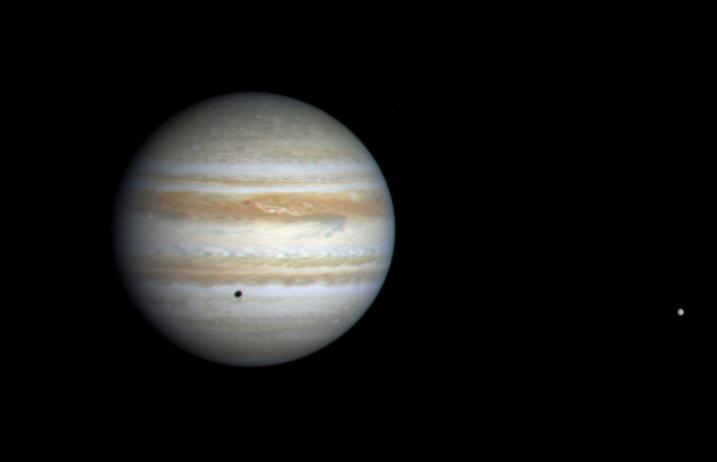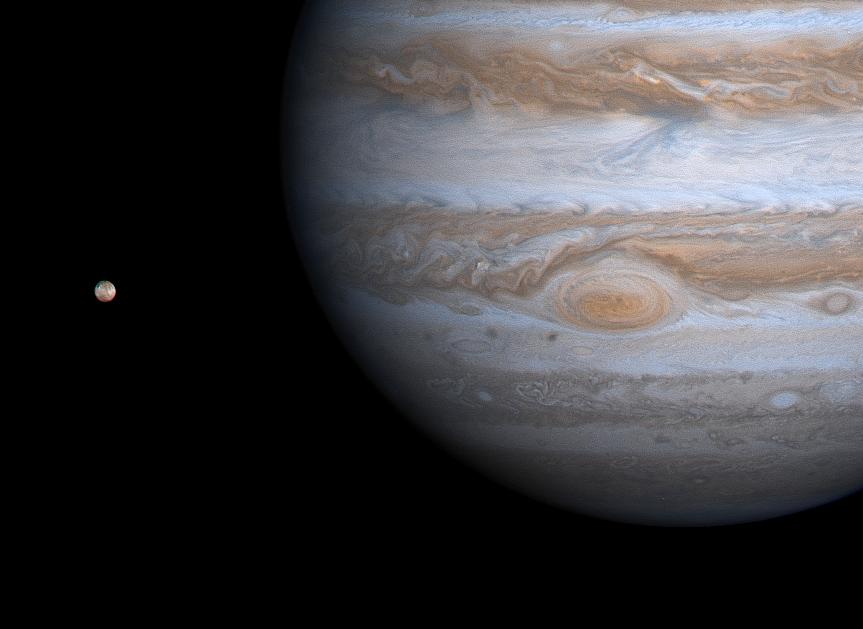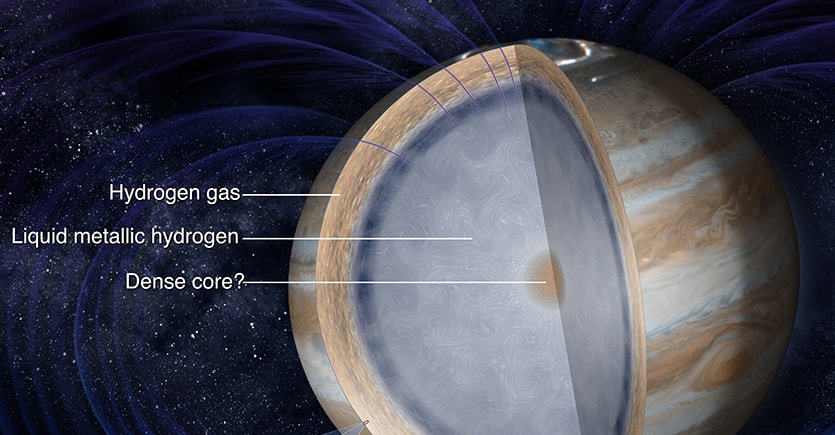Last updated on January 27th, 2024
Our Solar System is vast and there are multitudes of things that are being discovered about it by scientists all over the world. Jupiter is an important planet and in recent years, a lot of important information and data about it has been gathered by various space agencies. With these facts about Jupiter, let’s learn more about this gas giant.
Facts About Jupiter
1. Jupiter is the fifth planet from the Sun in the solar system and the largest of all. (Order of the planets from the Sun: Mercury, Venus, Earth, Mars, Jupiter, Saturn, Uranus, Neptune, and Pluto (the dwarf planet)).
“Jupiter is 11 times wider than THE Earth.”
2. Jupiter is the third brightest planet in the night sky after Earth’s moon and Venus.
3. Jupiter is the fourth brightest natural object in Earth’s sky, following the Sun, the Moon, and Venus. It can be seen during the daytime, and its four largest moons can be seen through a small telescope.
4. Jupiter is a gas giant mostly composed of hydrogen and helium and, unlike the Earth, does not have a hard surface. Besides these two elements, Jupiter contains trace amounts of methane, water vapour, ammonia and silicon-based compounds, as well as carbon, ethane, hydrogen sulphide, neon, oxygen, phosphine and sulphur.
5. Jupiter, like other most planets, is not a well defined solid object. It mainly consists of gaseous matter.
6. Observations of Jupiter can be dated back to Babylonian astronomers in the 7th or 8th century BC. The four largest moons were discovered in 1610 by Galileo Galilei and Simon Marius, independently (although Marius’ discovery was not published until 1614), and the names given by Marius – Io, Europa, Ganymede, and Callisto – remain until this day.

7. Jupiter was formed 4.5 billion years ago (almost 50 million years before Earth), by gravity pulling gas and dust together, and settled in its current position 4 billion years ago.
8. Although the name “Jupiter” was used for centuries, the International Astronomical Union (IAU), which is the international authority for assigning designations to celestial bodies, officially used the name for the first time in its Resolution No. 10, which was approved by the XVIth General Assembly of the IAU in 1976.
9. Jupiter is 5.2 astronomical units away from the Sun, that is, 5.2 times the distance between the Sun and the Earth.
10. It takes Jupiter almost 12 Earth years to orbit around the Sun, but only 10 hours to rotate on its axis. It is the fastest rotating planet in the Solar System, having the shortest day.
11. Due to its fast rotation speed, Jupiter is not a sphere, but an oblate spheroid. It has an equatorial diameter of 139,822 kilometres (86,881.4 miles) which is 9,276 kilometres (5,764 miles) longer than its polar diameter. Its equatorial diameter is approximately 11 times wider than that of the Earth.
12. Jupiter’s equator is tilted 3.13 degrees with respect to its path around the Sun (orbital plane). As it is nearly upright, there are no major differences in seasons as it revolves around the sun (as a reference, the Earth is tilted between 22.1 and 24.5 degrees).
13. Jupiter has a mass 2.5 times greater than that of all the other planets in the Solar System combined.
14. The adjective “Jovian” is used to describe something related to or a characteristic of the planet Jupiter. For example, all its moons are called “Jovian satellites”.
15. Jupiter is famous for its Great Red Spot, which is a giant spot observed first in the 17th century. The giant Red Spot is a dust storm that is so immense that it gets larger than the size of Earth.
16. Four of the Jupiter’s moons were discovered by Galileo Galilei in 1610. These are the largest of all the moons that Jupiter has and are called the Galilean satellites.
“Ganymede (larger than Mercury and three-fourths the size of Mars) is the only moon in the solar system to have its own magnetic field.”
Ganymede quick facts
| Discovered by | Galileo Galilei |
|---|---|
| Discovery date | January 7, 1610 |
| Diameter | 5262.4 Km |
| Mass | 1.48 x 10^23 kg |
| Orbits | Jupiter |
| Orbit distance | 1,070,400 km |
| Orbit period | 7.16 days |
| Surface temperature | -163 degree Celcius |
17. Jupiter has been studied by at least 8 space crafts that have been sent to space for the mission. They were sent by NASA between 1979 and 2007. They are Pioneer 10, Pioneer-Saturn, Voyager 1, Voyager 2, Ulysses, Galileo, Cassini, and New Horizons.
18. Jupiter is also famous for its colored clouds that are red, brown, yellow and white. These clouds appear as strips on the planet and impart Jupiter a very distinctive look.
19. Jupiter’s ring system has three main components that were spotted for the first time in 1976 by Voyager. They are named: Halo (a thick inner ring), Main (a wide and flat ring) and Gossamer rings (a pair of faint outer rings).

20. Jupiter has the strongest magnetic field in the solar system, except that of the Sun.
“More than 1,300 Earths would fit inside Jupiter.”
21. Jupiter spins faster than any other planet in the solar system.
22. As Jupiter spins at a high speed, and because of the lack of solid mass in the planet’s composition, Jupiter has flattened out at the poles and has bulged at the equator.
23. It also has an ocean of liquid Hydrogen, which is responsible for almost all the power that this giant planet has. Due to the high speed with which the planet spins, the liquid inside the planet attracts everything that comes in its vicinity and produces a strong magnetic field.
24. Jupiter is also accredited with having the largest moon in the solar system – Ganymede (diameter – 5262 kilometers). This was also discovered by Galileo, and this moon is even bigger than the planet Mercury.
25. A special spacecraft – Juno – was sent by NASA in 2011 which reached its orbit around Jupiter on July 4th, 2016. It is expected that this spacecraft will send a lot of potential data about Jupiter back to Earth.
26. Jupiter also has the ability to alter the orbit of other planets such as Mars and that’s mainly because of its weight.
“Pioneer 10 was the first mission launched to study Jupiter in 1972.”
27. Jupiter is also nicknamed “vacuum cleaner of the solar system” because of its ability to attract other heavenly bodies into it due to its sheer mass and strong magnetic field.
28. Jupiter helps the earth by deflecting comets and asteroids away from it. Otherwise, these comets and asteroids could strike Earth causing potential damage.
29. Scientists believe that Jupiter could have been a star had it been 80 times more massive than what it is today.
30. Jupiter is the biggest source of radio emissions in the sky. Its radio waves are even received on Earth but are mostly below the audible level for humans.
31. Ice vs Gas: Uranus and Neptune are ice giants while Jupiter and Saturn are gas giants.
32. Jupiter can easily put to fire anything that comes in its contact. Thus, the spacecraft sent to study the planet are always at a risk of burning down when they have to come close to the planet for making the required observations.
“The Great Red Spot — first identified in 1665 — is a monster storm on Jupiter which is twice the size of Earth and has been in existence for over 350 years now.”

33. Jupiter is 318 times heavier than earth.
34. Jupiter’s mass is one-thousandth that of Sun’s mass.
35. Jupiter has 95 moons that are officially recognized by the International Astronomical Union (IAU). The largest ones – Io, Europa, Ganymede, and Callisto – are known as the Galilean moons/satellites.

36. Io, or Jupiter I, is the innermost of the four Galilean moons, and is characterised by having more than 400 active volcanoes. The gases and dust from the volcanic eruptions, rich in ionized sulphur, oxygen and chlorine, load Jupiter’s magnetic field making it twice the size that it would otherwise be.
37. Europa, or Jupiter II, is the smallest of the Galilean moons. It has a water-ice crust and a thin atmosphere composed primarily of oxygen, which suggests it could be capable of supporting life. The planned Europa Clipper mission will orbit to confirm the presence of water, as well as analysing the moon’s chemical composition and geology.
38. Ganymede, or Jupiter III, is the largest natural satellite in the Solar System, being larger than the planet Mercury. Observations from both the Hubble space telescope and the Juno spacecraft indicate that it has an icy and rocky surface, and underneath it, there is a water ocean between two layers of ice.
39. Callisto, or Jupiter IV, has a heavily cratered surface and no indication of geological activity.
40. Traditionally, Jupiter’s moons were named after the god Jupiter/Zeus’ lovers and favourites, but as new satellites were discovered, the names of Jupiter/Zeus’ descendants were also allowed.
41. The composition of Jupiter is similar to that of the Sun.
42. Jupiter is a windy planet. It experiences wind speeds of 192 mph to more than 400 mph.
“Jupiter’s core is about 24000 degree Celsius. That is hotter than the surface of Sun.”

43. Jupiter is named after Jupiter, the king of the Roman gods in mythology.
44. An astronaut weighing 100 pounds on earth would weigh 240 pounds on Jupiter.
45. Jupiter’s magnetic field is 16 to 54 times as powerful as that of the earth.
46. Another interesting fact about Jupiter is that the planet’s equator rotates at a different speed than its polar regions. A day at its equator is around 9 hours 50 minutes long while that at its poles is 9 hours and 56 minutes long.
47. The length of each season on Jupiter is roughly three years.
48. Jupiter has an average temperature of minus 145 degree Celsius. However, it is a notable fact here that the temperature of Jupiter changes not due to the change in its distance from the Sun but due to the change in its height above its surface, meaning that the regions near the core of the planet are hotter than those away from it.
49. Jupiter emits more heat than it receives from the Sun, almost twice its intake.
“Jupiter has the shortest day in the Solar system.”
50. Jupiter has the largest ocean in the Solar System, an ocean made up of liquid hydrogen instead of water.
51. A spacecraft couldn’t potentially land on Jupiter because of lack of a solid surface. The planet is built mostly from gasses and liquids that are swirling around.
52. Europa — one of Jupiter’s moons — is one of the likeliest places to find life elsewhere in our solar system.
53. On 7th December 1995, the first samples of Jupiter’s atmosphere were collected by NASA’s Galileo orbiter. The probe penetrated 200 km into Jupiter’s atmosphere and lasted for 58 minutes before being destroyed.
. . . continue reading on the next page
